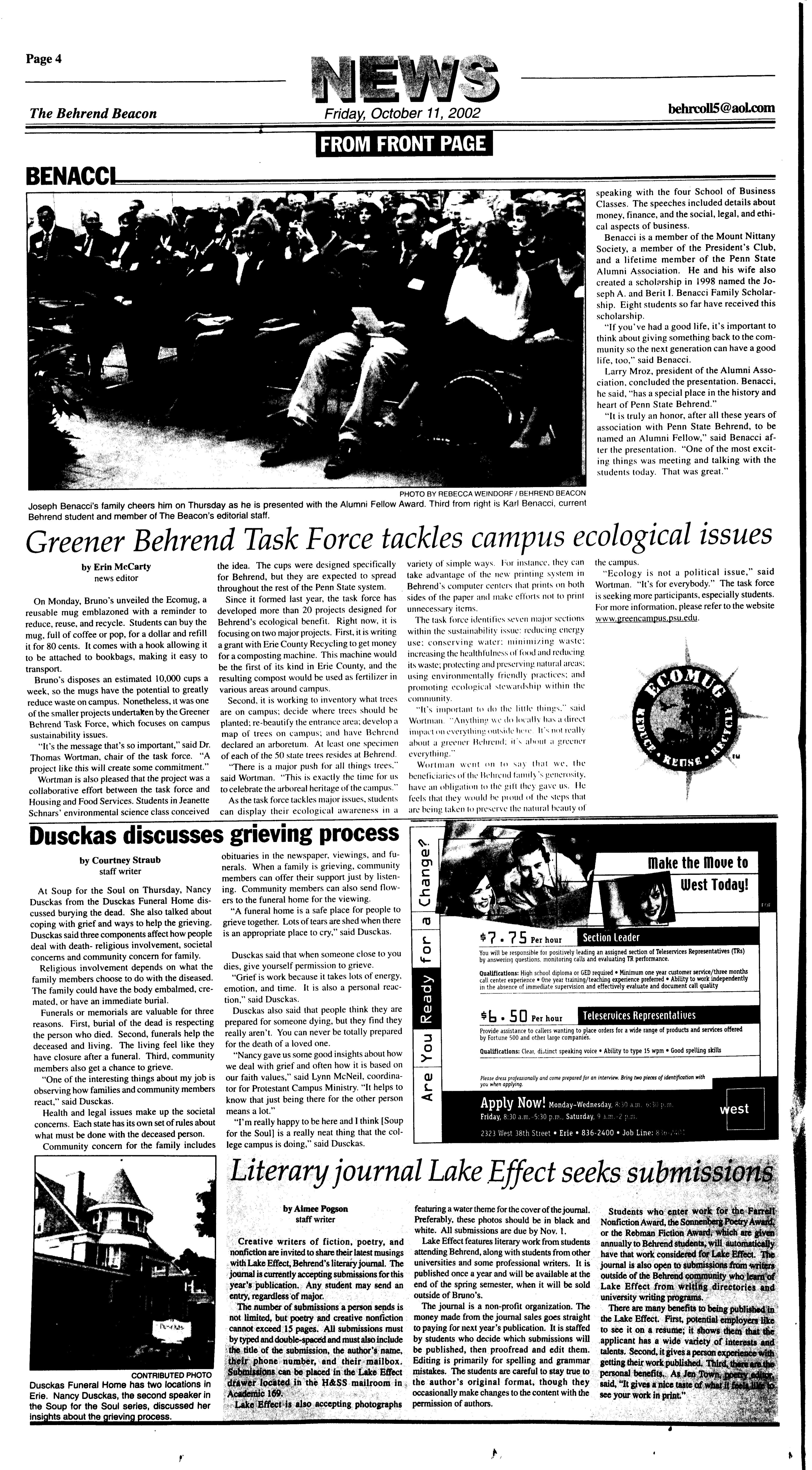
Issue Date: 2002-10-11
Title: Greener Behrend Task Force tackles campus
ecological issues
Author: Erin McCarty
On Monday, Bruno's unveiled the Ecomug, a reusable mug emblazoned
with a reminder to reduce, reuse, and recycle. Students can buy the mug, full of
coffee or pop, for a dollar and refill it for 80 cents. It comes with a hook allowing
it to be attached to bookbags, making it easy to transport.
Bruno's disposes an estimated 10,000 cups a week, so the mugs have
the potential to greatly reduce waste on campus. Nonetheless, it was one of the
smaller projects undertaken by the Greener Behrend Task Force, which focuses on
campus sustainability issues.
"It's the message that's so important," said Dr. Thomas Wortman,
chair of the task force. "A project like this will create some commitment."
Wortman is also pleased that the project was a collaborative effort
between the task force and Housing and Food Services. Students in Jeanette Schnars'
environmental science class conceived the idea. The cups were designed specifically
for Behrend, but they are expected to spread throughout the rest of the Penn State
system.
Since it formed last year, the task force has developed more than 20
projects designed for Behrend's ecological benefit. Right now, it is focusing on two
major projects. First, it is writing a grant with Erie County Recycling to get money
for a composting machine. This machine would be the first of its kind in Erie County,
and the resulting compost would be used as fertilizer in various areas around
campus.
Second, it is working to inventory what trees are on campus; decide
where trees should be planted; re-beautify the entrance area; develop a map of trees
on campus; and have Behrend declared an arboretum. At least one specimen of each of
the 50 state trees resides at Behrend.
"There is a major push for all things trees." said Wortman. "This is
exactly the time for us to celebrate the arboreal heritage of the campus."
As the task force tackles major issues, students can display their
ecological awareness in a variety of simple ways. For instance, they can take
advantage of the new printing system in Behrend's computer centers that prints on
both sides of the paper and make efforts not to print unnecessary items.
The task force identifies seven major sections within the
sustainahility issue: reducing energy use: conserving water: minimizing waste:
increasing the healthfulness of food and reducing its waste; protecting and
preserving natural areas; using environmentally friendly practices; and promoting
ecological stewardship within the community.
"It's important to do the little things. - said Wortman. "Anything we
do locally has a direct impact on everything_ outside hcie It's not wally about a
greener Behrend: it ., about a greener everything."
Wortman went on to say that we, the beneficiaries of the Behrend
family's generosity, have an obligation to the gift they gave us. He feels that they
would he proud of the steps that are being taken to preserve the natural beauty of
the campus.
"Ecology is not a political issue," said Wortman. "It's for
everybody." The task force is seeking more participants, especially students. For
more information, please refer to the website www.greencampus.psu.edu
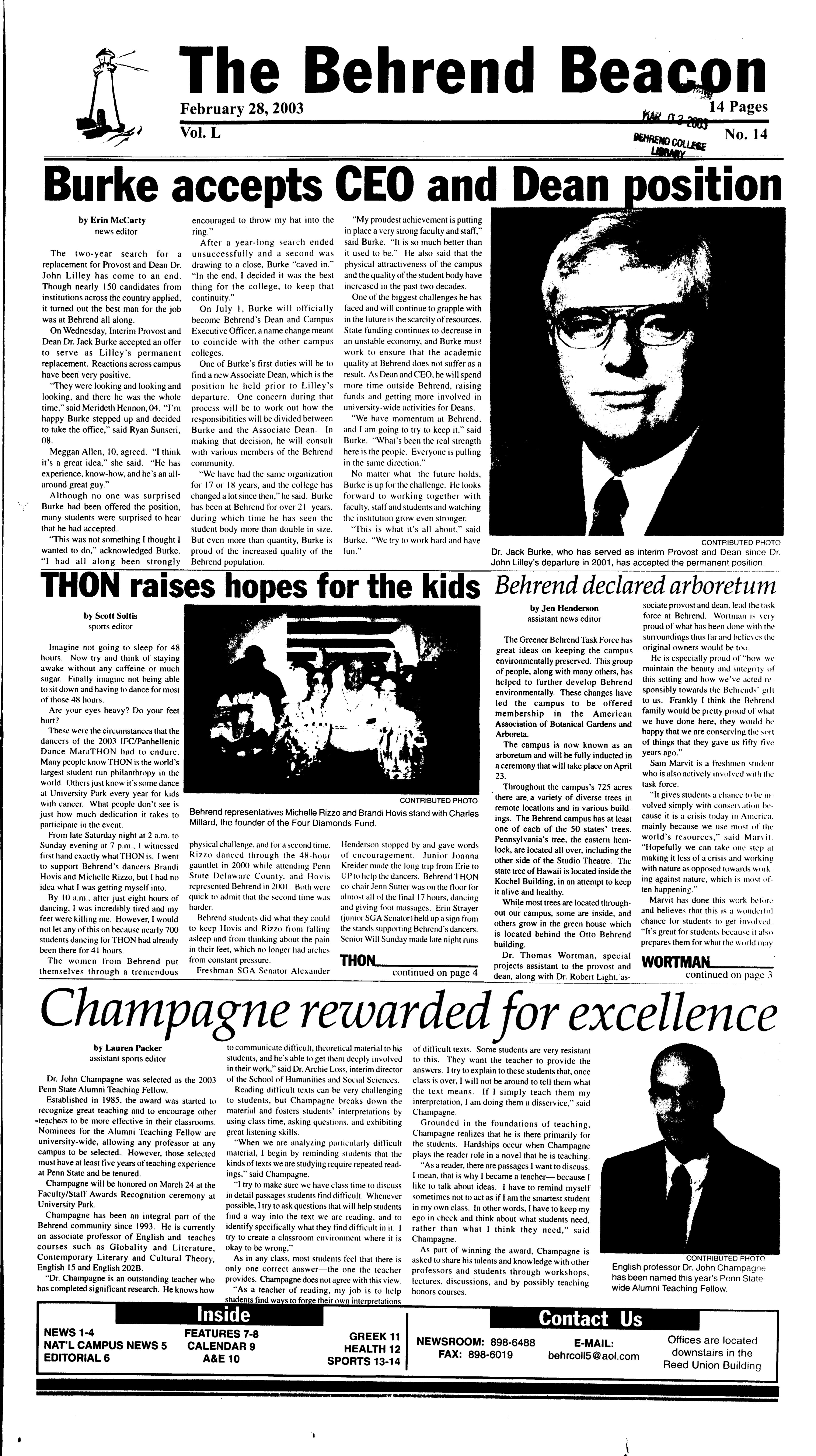
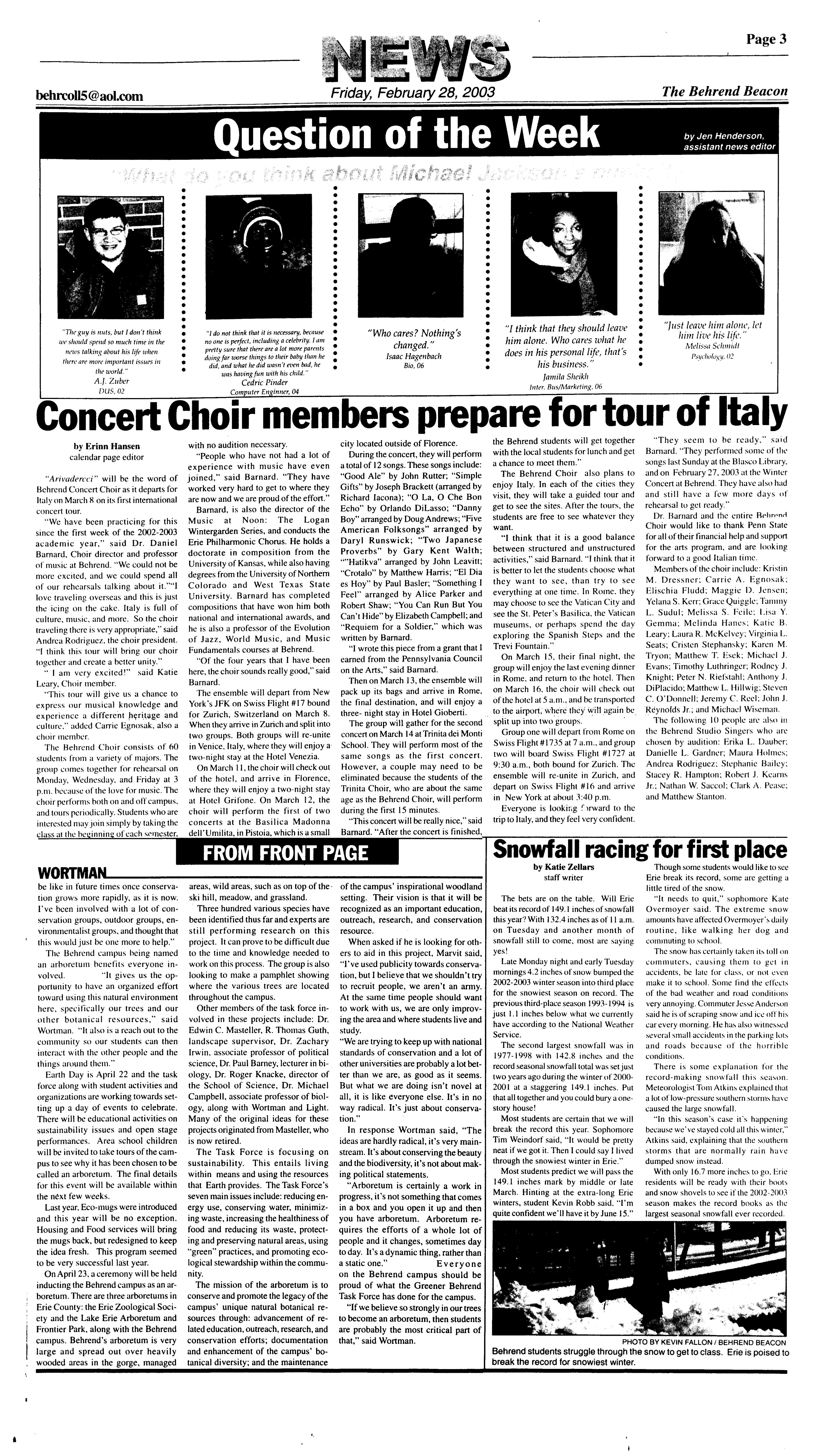
Issue Date: 2003-02-28
Title: Behrend Declared Arboretum
Author: Jen Henderson
The Greener Behrend Task Force has great ideas on keeping the campus
environmentally preserved. This group of people, alongwith many others, has helped to
further develop Behrend environmentally. These changes have led the campus to be
offered membership in the American Association of Botanical Gardens and
Arboreta.
The campus is now known as an arboretum and will be fully inducted in
a ceremony that will take place on April 23
Throughout the campus's 725 acres there are a variety of diverse
trees in remote locations and in various buildings. The Behrend campus has at least
one of each of the 50 states' trees. Pennsylvania's tree, the eastern hemlock, are
located all over, including the other side of the Studio Theatre. The state tree
ofHawaii is located inside the Kochel Building, in an attempt to keep it alive and
healthy
While most trees are located throughout our campus, some are inside,
and others grow in the green house which is located behind the Otto Behrend
building.
Dr. Thomas Wortman, special projects assistant to the provost and
dean, along with Dr. Robert Light, associate provost and dean, lead the task force at
Behrend. Wortman is very proud of what has been done with the surroundings thus far
and believes the original owners would be too.
He is especially proud of "how we maintain the beauty and integrity
of this setting and how we've acted responsibly towards the Behrends' gift to us.
Frankly I think the Behrend family would be pretty proud of what we have done here,
they would he happythat we are conserving the sort ofthings that they gave us fifty
five years ago."
Sam Marvit is a freshman student who is also actively involved with
the task force.
"It gives students a chance to he involved simply with consen ation
because it is a crisis today in America, mainly because we use most of the world's
resources," said Mary it "Hopefully we can take one step at making it less of a
crisis and working with nature as opposed towards working against nature, which is
most often happening."
Marvit has done this work before and believes that this is a
wonderful chance for students to get invoked. "It's great for students because it
also prepares them for what the world may be like in future times once conservation
grows more rapidly, as it is now. I've been involved with a lot of conservation
groups, outdoor groups, environmentalist groups, and thought that this would just be
one more to help."
The Behrend campus being named an arboretum benefits everyone
involved. "It gives us the opportunity to have an organized effort toward using this
natural environment here, specifically our trees and our other botanical resources."
said Wortman. "It also is a reach out to the community so our students can then
interact with the other people and the things around them."
Earth Day is April 22 and the task force along with student
activities and organizations are working towards setting up a day of events to
celebrate. There will be educational activities on sustainability issues and open
stage performances. Area school children will be invited to take tours ofthe campus
to see why it has been chosen to be called an arboretum. The final details for this
event will be available within the next few weeks
Last year, Eco-mugs were introduced and this year will be no
exception. Housing and Food services will bring the mugs back, but redesigned to keep
the idea fresh. This program seemed to be very successful last year.
On April 23, a ceremony will be held inducting the Behrend campus as
an arboretum. There are three arboretums in Erie County: the Erie Zoological Society
and the Lake Erie Arboretum and Frontier Park, along with the Behrend campus.
Behrend's arboretum is very large and spread out over heavily wooded areas in the
gorge, managed areas, wild areas, such as on top ofthe ski hill, meadow, and
grassland.
Three hundred various species have been identified thus far and
experts are still performing research on this project. It can prove to be difficult
due to the time and knowledge needed to work on this process. The group is also
looking to make a pamphlet showing where the various trees are located throughout the
campus.
Other members of the task force involved in these projects include:
Dr. Edwin C. Masteller, R. Thomas Guth, landscape supervisor, Dr. Zachary Irwin,
associate professor of political science, Dr. Paul Barney, lecturer in biology, Dr.
Roger Knacke, director of the School of Science, Dr. Michael Campbell, associate
professor of biology, along with Wortman and Light. Many of the original ideas for
these projects originated from Masteller, who is now retired.
The Task Force is focusing on sustainability. This entails living
within means and using the resources that Earth provides. The Task Force's seven main
issues include: reducing energy use, conserving water, minimizing waste, increasing
the healthiness of food and reducing its waste, protecting and preserving natural
areas, using "green" practices, and promoting ecological stewardship within the
community.
The mission of the arboretum is to conserve and promote the legacy
ofthe campus' unique natural botanical resources through: advancement of related
education, outreach, research, and conservation efforts; documentation and
enhancement of the campus' botanical diversity; and the maintenance of the campus'
inspirational woodland setting. Their vision is that it will be recognized as an
important education, outreach research, and conservation resource.
When asked if he is looking for others to aid in this project, Marvit
said, "I've used publicity towards conservation, but I believe that we shouldn't try
to recruit people, we aren't an army. At the same time people should want to work
with us, we are only improving the area and where students live and study.
"We are trying to keep up with national standards of conservation and
a lot of other universities are probably a lot better than we are, as good as it
seems. But what we are doing isn't novel at all, it is like everyone else. It's in no
way radical. It's just about conservation."
In response Wortman said, "The ideas are hardly radical, it's very
mainstream. It's about conservingthe beauty and the biodiversity, it's not about
making political statements.
"Arboretum is certainly a work in progress, it's not somethingthat
comes in a box and you open it up and then you have arboretum. Arboretum requires the
efforts of a whole lot of people and it changes, sometimes day to day. It's a dynamic
thing, rather than a static one."
Everyone on the Behrend campus should be proud of what the Greener
Behrend Task Force has done for the campus. "If we believe so strongly in our trees
to become an arboretum, then students are probably the most critical part of that,"
said Wortman.
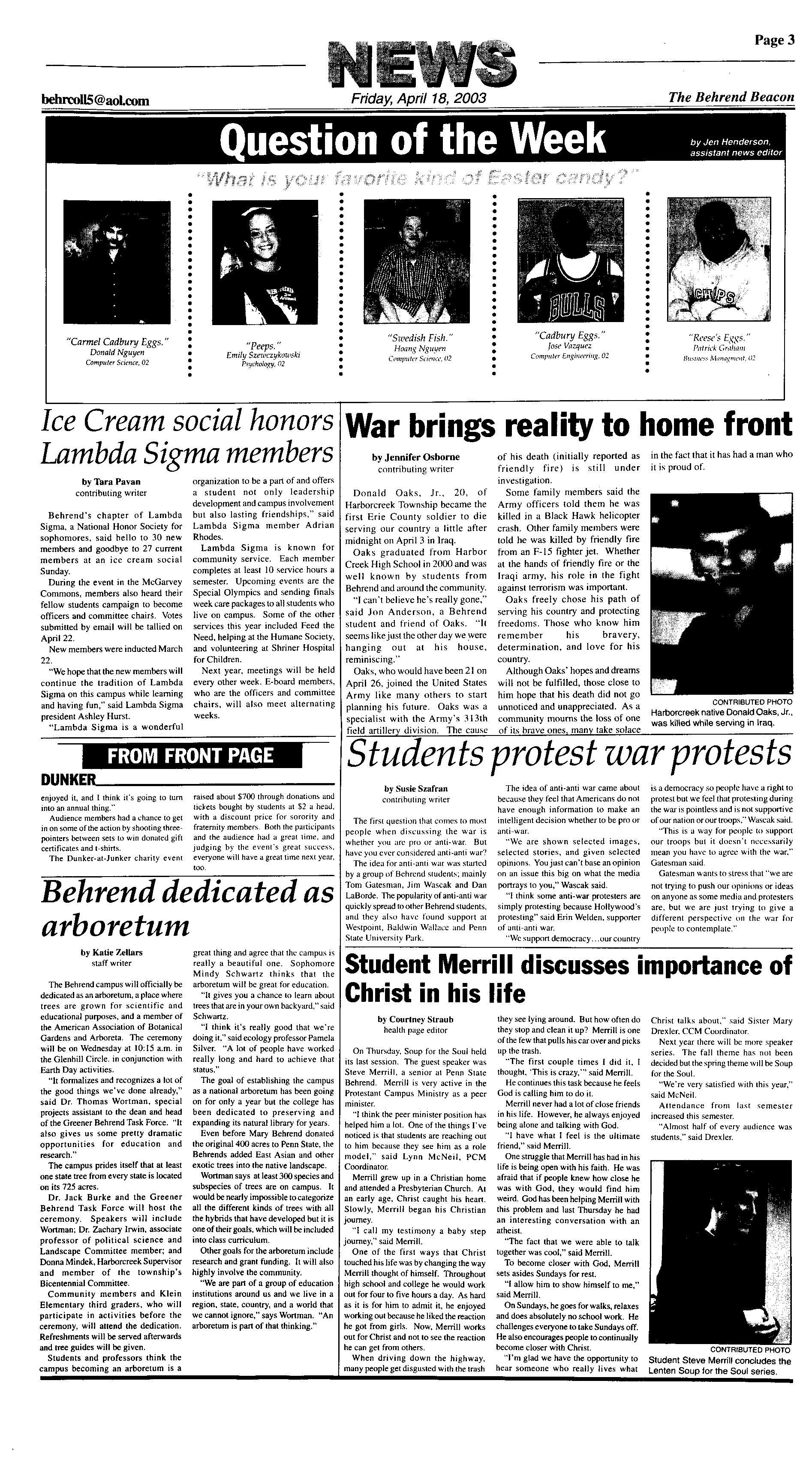
Issue Date: 2003-04-18
Title: Behrend dedicated as arboretum
Author: Katie Zellars
The Behrend campus will officially be dedicated as an arboretum, a
place where trees are grown for scientific and educational purposes, and a member of
the American Association of Botanical Gardens and Arboreta. The ceremony will be on
Wednesday at 10:15 a.m. in the Glenhill Circle. in conjunction with Earth Day
activities.
"It formalizes and recognizes a lot of the good things we've done
already," said Dr. Thomas Wortman, special projects assistant to the dean and head of
the Greener Behrend Task Force. "It also gives us some pretty dramatic opportunities
for education and research."
The campus prides itself that at least one state tree from every
state is located on its 725 acres.
Dr. Jack Burke and the Greener Behrend Task Force will host the
ceremony. Speakers will include Wortman; Dr. Zachary Irwin, associate professor of
political science and Landscape Committee member; and Donna Mindek, Harborcreek
Supervisor and member of the township's Bicentennial Committee.
Community members and Klein Elementary third graders, who will
participate in activities before the ceremony, will attend the dedication.
Refreshments will be served afterwards and tree guides will be given.
Students and professors think the campus becoming an arboretum is a
great thing and agree that the campus is really a beautiful one. Sophomore Mindy
Schwartz thinks that the arboretum will be great for education.
"It gives you a chance to learn about trees that are in your own
backyard," said Schwartz.
"I think it's really good that we're doing it," said ecology
professor Pamela Silver. "A lot of people have worked really long and hard to achieve
that status."
The goal of establishing the campus as a national arboretum has been
going on for only a year but the college has been dedicated to preserving and
expanding its natural library for years.
Even before Mary Behrend donated the original 400 acres to Penn
State, the Behrends added East Asian and other exotic trees into the native
landscape.
Wortman says at least 300 species and subspecies of trees are on
campus. It would be nearly impossible to categorize all the different kinds of trees
with all the hybrids that have developed but it is one of their goals, which will be
included into class curriculum.
Other goals for the arboretum include research and grant funding. It
will also highly involve the community.
"We are part of a group of education institutions around us and we
live in a region, state, country, and a world that we cannot ignore," says Wortman.
"An arboretum is part of that thinking."
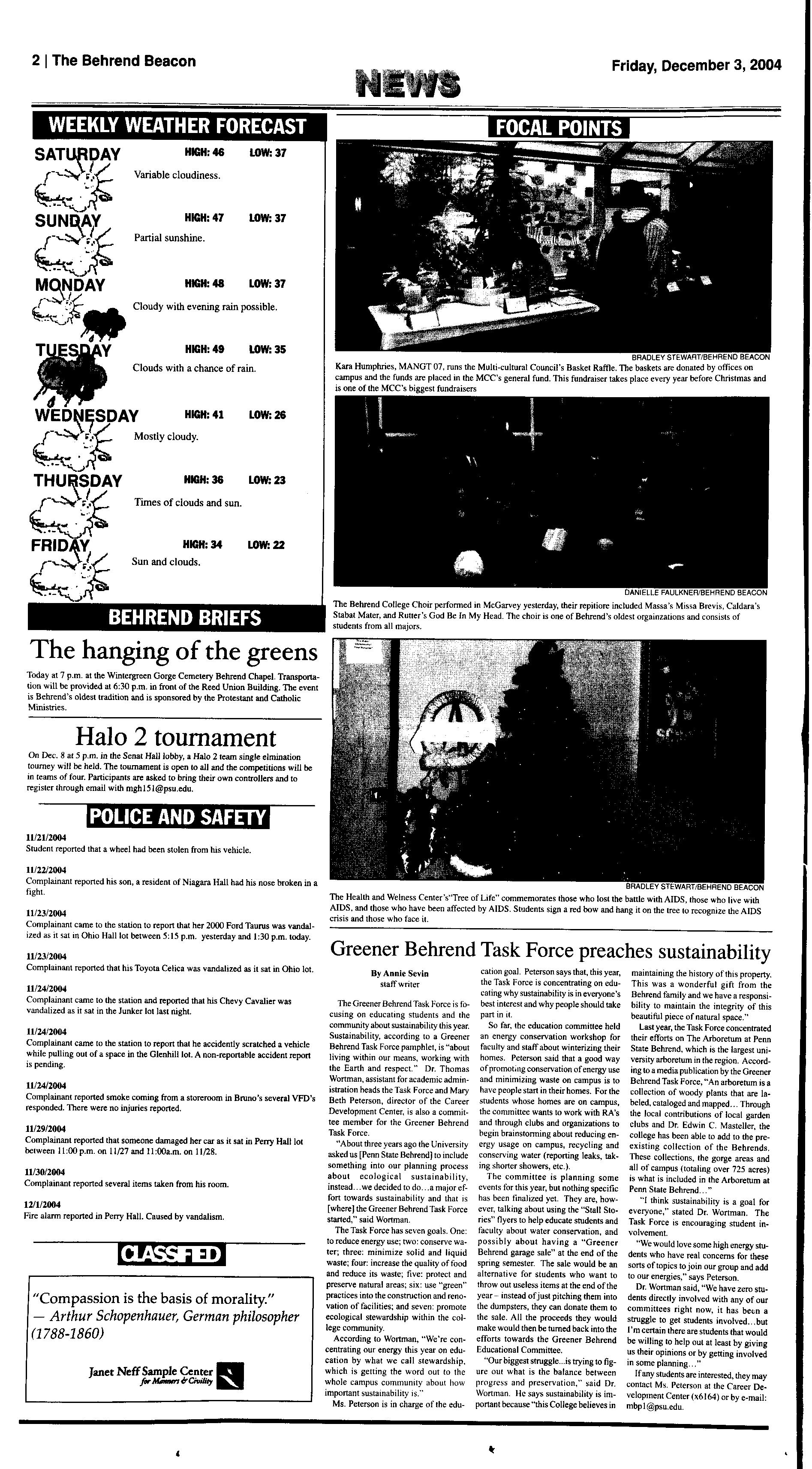
Issue Date: 2004-01-03
Title: Greener Behrend Task Force preaches
sustainability
Author: Annie Sevin
The Greener Behrend Task Force is fo cusing on educating students and
the community about sustainability this year. Sustainability, according to a Greener
Behrend Task Force pamphlet, is “about living within our means, working with the
Earth and respect.” Dr. Thomas Wortman, assistant for academic admin istration heads
the Task Force and Mary Beth Peterson, director of the Career Development Center, is
also a committee member for the Greener Behrend Task Force.
“About three years ago the University asked us [Penn State Behrend]
to include something into our planning process about ecological sustainability,
instead.. .we decided to do.. .a major ef fort towards sustainability and that is
[where] the Greener Behrend Task Force started,” said Wortman.
The Task Force has seven goals. One: to reduce energy use; two:
conserve wa ter; three: minimize solid and liquid waste; four: increase the quality
of food and reduce its waste; five: protect and preserve natural areas; six: use
“green” practices into the construction and reno vation of facilities; and seven:
promote ecological stewardship within the col lege community.
According to Wortman, “We’re con centrating our energy this year on
edu cation by what we call stewardship, which is getting the word out to the whole
campus community about how important sustainability is.” Ms. Peterson is in charge of
the edu cation goal. Peterson says that, this year, the Task Force is concentrating
on educating why sustainability is in everyone’s best interest and why people should
take part in it.
So far, the education committee held an energy conservation workshop
for faculty and staff about winterizing their homes. Peterson said that a good way of
promoting conservation of energy use and minimizing waste on campus is to have people
start in their homes. For the students whose homes are on campus, the committee wants
to work with RA’s and through clubs and organizations to begin brainstorming about
reducing en ergy usage on campus, recycling and conserving water (reporting leaks,
tak ing shorter showers, etc.).
The committee is planning some events for this year, but nothing
specific has been finalized yet. They are, how ever, talking about using the “Stall
Stories” flyers to help educate students and faculty about water conservation, and
possibly about having a “Greener Behrend garage sale” at the end of the spring
semester. The sale would be an alternative for students who want to throw out useless
items at the end of the year - instead of just pitching them into the dumpsters, they
can donate them to the sale. All the proceeds they would make would then be turned
back into the efforts towards the Greener Behrend Educational Committee.
“Our biggest struggle...is trying to fig ure out what is the balance
between progress and preservation,” said Dr. Wortman. He says sustainability is im
portant because “this College believes in Friday, December 3, 2004 maintaining the
history of this property. This was a wonderful gift from the Behrend family and we
have a responsi bility to maintain the integrity of this beautiful piece of natural
space.”
Last year, the Task Force concentrated their efforts on The Arboretum
at Penn State Behrend, which is the largest uni versity arboretum in the region.
Accord ing to a media publication by the Greener Behrend Task Force, “An arboretum is
a collection of woody plants that are labeled, cataloged and mapped... Through the
local contributions of local garden clubs and Dr. Edwin C. Masteller, the college has
been able to add to the pre existing collection of the Behrends. These collections,
the gorge areas and all of campus (totaling over 725 acres) is what is included in
the Arboretum at Penn State Behrend...”
“I think sustainability is a goal for everyone,” stated Dr. Wortman.
The Task Force is encouraging student in volvement.
“We would love some high energy stu dents who have real concerns for
these sorts of topics to join our group and add to our energies,” says Peterson. Dr.
Wortman said, “We have zero students directly involved with any of our committees
right now, it has been a struggle to get students involved...but I’m certain there
are students that would be willing to help out at least by giving us their opinions
or by getting involved in some planning...”
If any students are interested, they may contact Ms. Peterson at the
Career Development Center (x 6164) or by e-mail: mbpl@psu.edu.
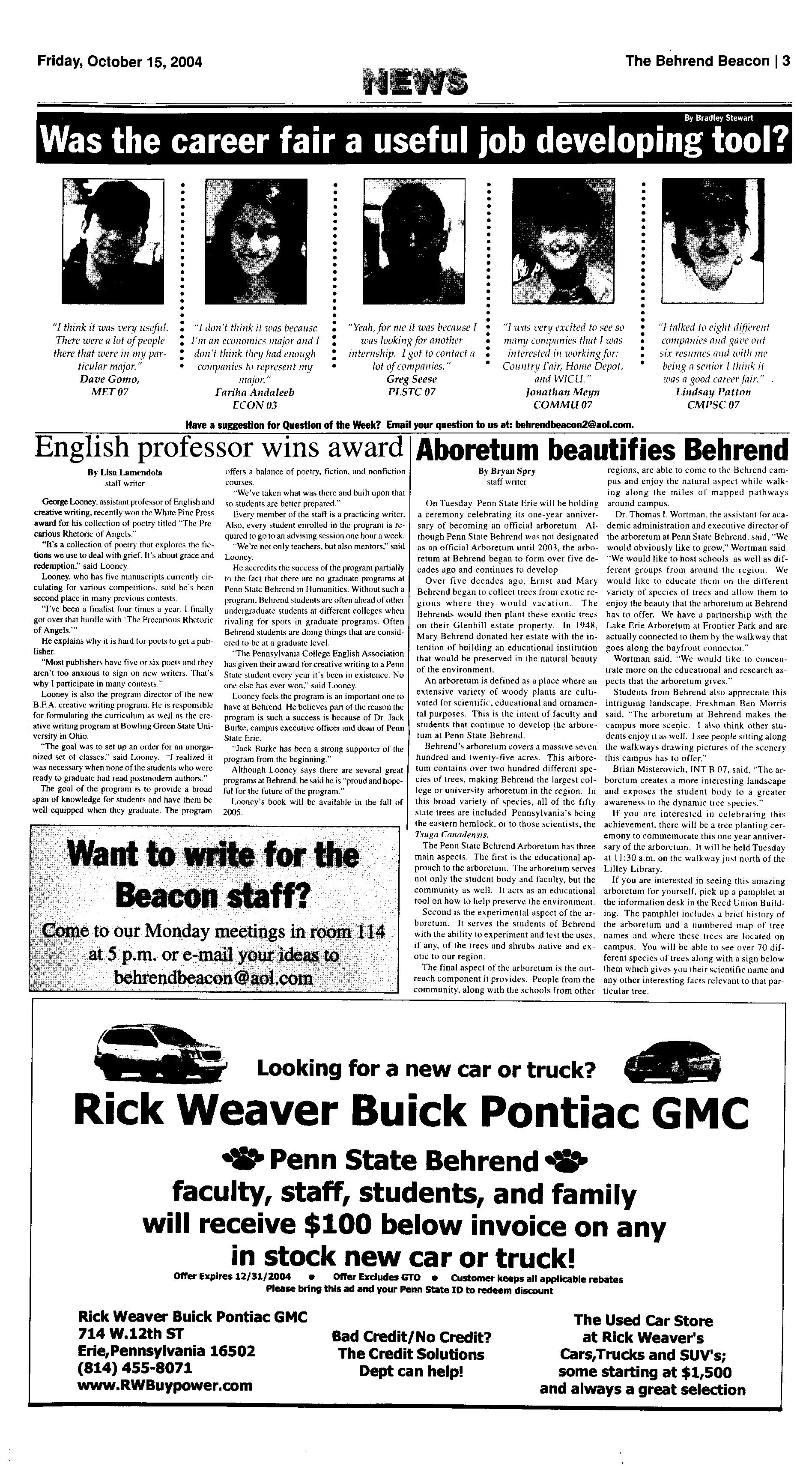
Issue Date: 2004-10-15
Title: Aboretum beautifies Behrend
Author: Bryan Spry
On Tuesday Penn State Erie will be holding a ceremony celebrating its
one-year anniver sary of becoming an official arboretum. Al though Penn State Behrend
was not designated as an official Arboretum until 2003, the arbo retum at Behrend
began to form over five de cades ago and continues to develop.
Over five decades ago, Ernst and Mary Behrend began to collect trees
from exotic re gions where they would vacation. The Behrends would then plant these
exotic trees on their Glenhill estate property. In 1948, Mary Behrend donated her
estate with the in tention of building an educational institution that would be
preserved in the natural beauty of the environment.
An arboretum is defined as a place where an extensive variety of
woody plants are culti vated for scientific, educational and ornamen tal purposes.
This is the intent of faculty and students that continue to develop the arbbre tum at
Penn State Behrend.
Behrend’s arboretum covers a massive seven hundred and twenty-five
acres. This arbore tum contains over two hundred different spe cies of trees, making
Behrend the largest col lege or university arboretum in the region. In this broad
variety of species, all of the fifty state trees are included Pennsylvania’s being
the eastern hemlock, or to those scientists, the Tsuga Canadensis.
The Penn State Behrend Arboretum has three main aspects. The first is
the educational ap proach to the arboretum. The arboretum serves not only the student
body and faculty, but the community as well. It acts as an educational tool on how to
help preserve the environment. Second is the experimental aspect of the ar boretum.
It serves the students of Behrend with the ability to experiment and test the uses,
if any, of the trees and shrubs native and ex otic to our region.
Dr. Thomas I. Wortman, the assistant for aca demic administration and
executive director of the arboretum at Penn State Behrend, said, “We would obviously
like to grow,” Wortman said. “We would like to host schools as well as dif ferent
groups from around the region. We would like to educate them on the different variety
of species of trees and allow them to enjoy the beauty that the arboretum at Behrend
has to offer. We have a partnership with the Lake Erie Arboretum at Frontier Park and
are actually connected to them by the walkway that goes along the bayfront
connector.”
Wortman said, “We would like to concen trate more on the educational
and research as pects that the arboretum gives.”
Students from Behrend also appreciate this intriguing landscape.
Freshman Ben Morris said, “The arboretum at Behrend makes the campus more scenic. I
also think other stu dents enjoy it as well. I see people sitting along the walkways
drawing pictures of the scenery this campus has to offer.”
Brian Misterovich, INT B 07, said, “The ar- boretum creates a more
interesting landscape and exposes the student body to a greater awareness to the
dynamic tree species.” If you are interested in celebrating this achievement, there
will be a tree planting cer emony to commemorate this one year anniver sary of the
arboretum. It will be held Tuesday at 11:30 a.m. on the walkway just north of the
Lilley Library.
If you are interested in seeing this amazing arboretum for yourself,
pick up a pamphlet at the information desk in the Reed Union Build ing. The pamphlet
includes a brief history of the arboretum and a numbered map of tree names and where
these trees are located on campus. You will be able to see over 70 dif ferent species
of trees along with a sign below them which gives you their scientific name and any
other interesting facts relevant to that par ticular tree.
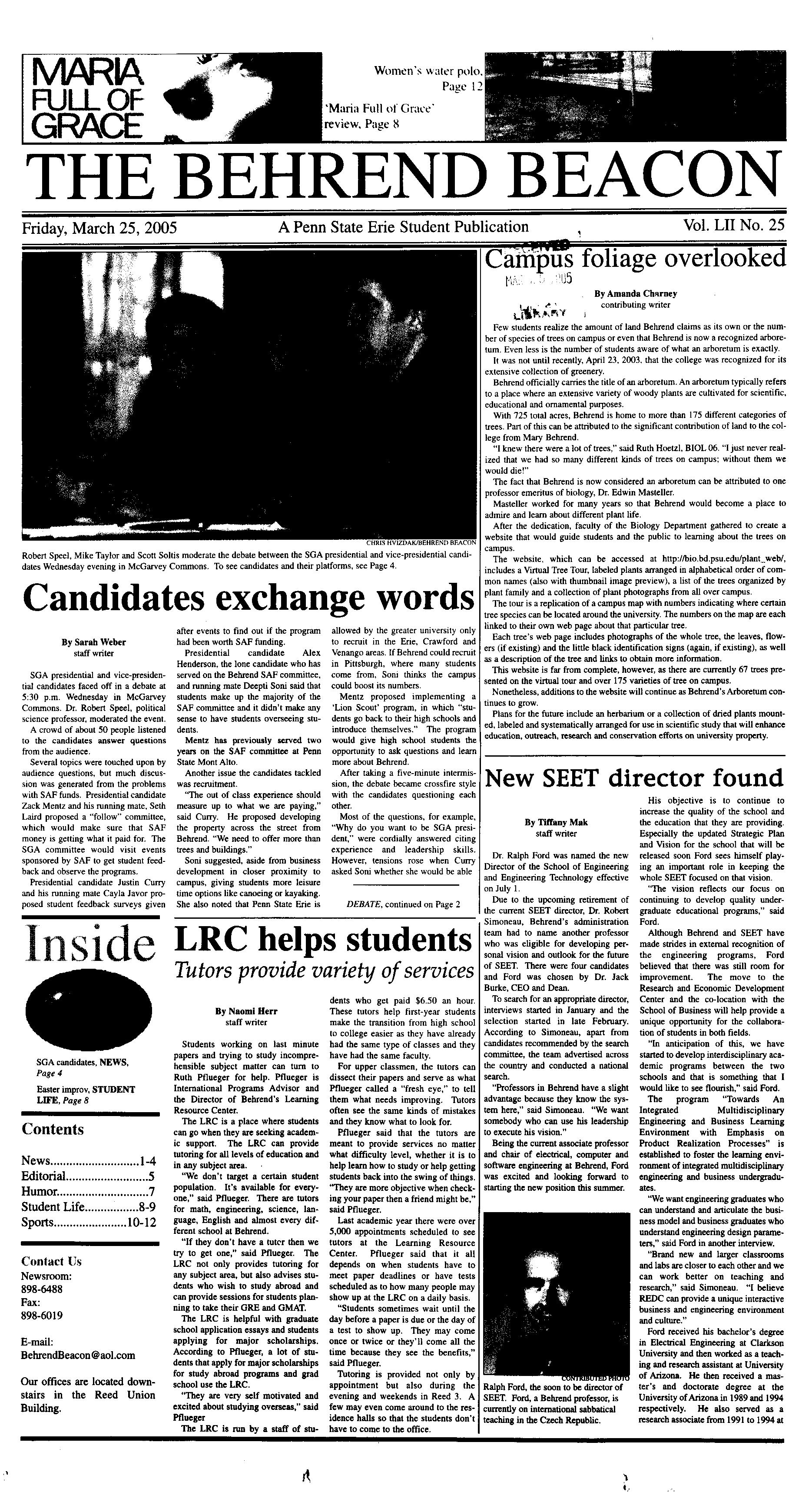
Issue Date: 2005-03-25
Title: Campus foliage overlooked
Author: Amanda Charney
Few students realize the amount of land Behrend claims as its own or
the num ber of species of trees on campus or even that Behrend is now a recognized
arbore tum. Even less is the number of students aware of what an arboretum is
exactly. It was not until recently, April 23, 2003, that the college was recognized
for its extensive collection of greenery.
Behrend officially carries the title of an arboretum. An arboretum
typically refers to a place where an extensive variety of woody plants are cultivated
for scientific, educational and ornamental purposes.
With 725 total acres, Behrend is home to more than 175 different
categories of trees. Part of this can be attributed to the significant contribution
of land to the col lege from Mary Behrend.
"I knew there were a lot of trees," said Ruth Hoetzl, BIOL 06. "I
just never real ized that we had so many different kinds of trees on campus; without
them we would die!"
The fact that Behrend is now considered an arboretum can be
attributed to one professor emeritus of biology, Dr. Edwin Masteller. Masteller
worked for many years so that Behrend would become a place to admire and learn about
different plant life. After the dedication, faculty of the Biology Department
gathered to create a website that would guide students and the public to learning
about the trees on campus
The website, which can be accessed at
http://bio.bd.psu.edu/plant_web/, includes a Virtual Tree Tour, labeled plants
arranged in alphabetical order of com mon names (also with thumbnail image preview),
a list of the trees organized by plant family and a collection of plant photographs
from all over campus.
The tour is a replication of a campus map with numbers indicating
where certain tree species can be located around the university. The numbers on the
map are each linked to their own web page about that particular tree.
Each tree's web page includes photographs of the whole tree, the
leaves, flow ers (if existing) and the little black identification signs (again, if
existing), as well as a description of the tree and links to obtain more
information.
This website is far from complete, however, as there are currently 67
trees pre sented on the virtual tour and over 175 varieties of tree on campus.
Nonetheless, additions to the website will continue as Behrend's Arboretum con tinues
to grow.
Plans for the future include an herbarium or a collection of dried
plants mount ed, labeled and systematically arranged for use in scientific study that
will enhance education, outreach, research and conservation efforts on university
property.
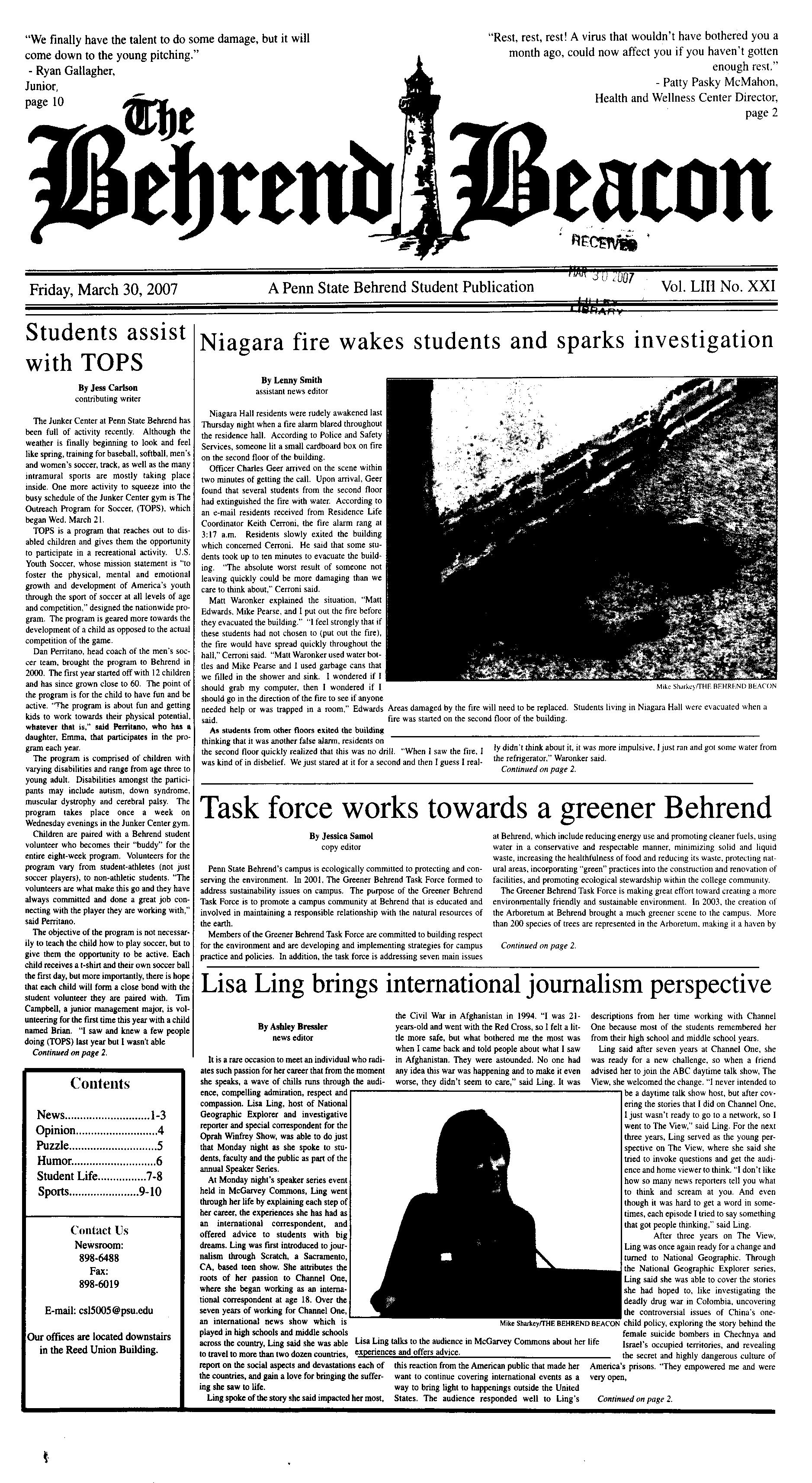
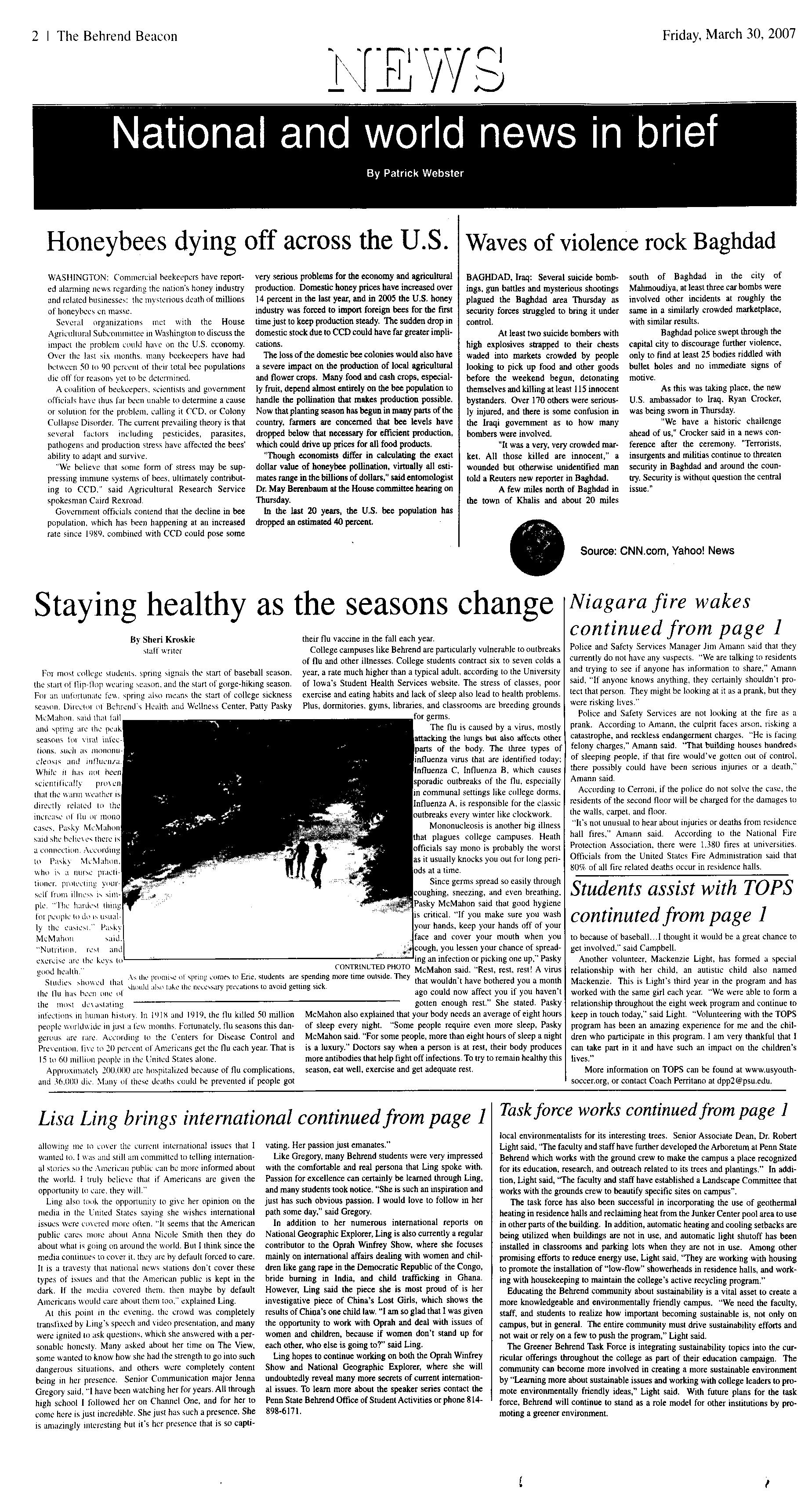
Issue Date: 2007-03-30
Title: Task force works towards a greener
Behrend
Author: Jessica Samol
Penn State Behrend's campus is ecologically committed to protecting
and conserving the environment. In 2001, The Greener Behrend Task Force formed to
address sustainability issues on campus. The purpose of the Greener Behrend Task
Force is to promote a campus community at Behrend that is educated and involved in
maintaining a responsible relationship with the natural resources of the earth.
Members of the Greener Behrend Task Force are committed to building
respect for the environment and are developing and implementing strategies for campus
practice and policies. In addition, the task force is addressing seven main issues at
Behrend, which include reducing energy use and promoting cleaner fuels, using water
in a conservative and respectable manner, minimizing solid and liquid waste,
increasing the healthfulness of food and reducing its waste, protecting natural
areas, incorporating "green" practices into the construction and renovation of
facilities, and promoting ecological stewardship within the college community.
The Greener Behrend Task Force is making great efforttoward creating
a more environmentally friendly and sustainable environment. In 2003, the creation of
the Arboretum at Behrend brought a much greener scene to the campus. More than 200
species oftrees are represented in the Arboretum, making it a haven by local
environmentalists for its interesting trees. Senior Associate Dean, Dr. Robert Light
said, "The faculty and staff have further developedthe Arboretum at Penn State
Behrend which works with the ground crew to make the campus a place recognized for
its education, research, and outreach related to its trees and plantings." In
addition, Light said, "The faculty and staff have established a Landscape Committee
that works with the grounds crew to beautify specific sites on campus".
The task force has also been successful in incorporating the use of
geothermal heating in residence halls and reclaiming heat from the Junker Center pool
area to use in other parts of the building. In addition, automatic heating and
cooling setbacks are being utilized when buildings are not in use, and automatic
light shutoff has been installed in classrooms and parking lots when they are not in
use. Among other promising efforts to reduce energy use, Light said, "They are
working with housing to promote the installation of"low-flow" showerheads in
residence halls, and working with housekeeping to maintain the college's
activerecycling program."
Educating the Behrend community about sustainability is a vital asset
to create a more knowledgeable and environmentally friendly campus. "We need the
faculty, staff, and students to realize how important becoming sustainable is, not
only on campus, but in general. The entire community must drive sustainability
efforts and not wait or rely on a few to push the program," Light said.
The Greener Behrend Task Force is integrating sustainability topics
into the curricular offerings throughout the college as part of their education
campaign. The community can become more involved in creating a more sustainable
environment by "Learningmore about sustainable issues and working with college
leaders to promote environmentally friendly ideas," Light said. With future plans for
the task force, Behrend will continue to stand as a role model for other institutions
by promoting a greener environment.
